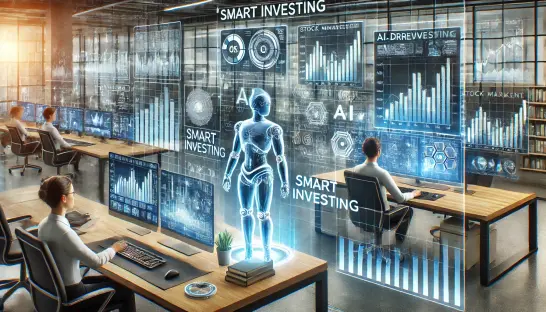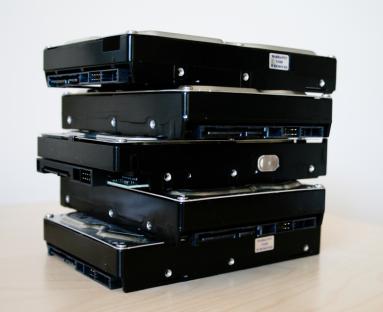Let’s be real—getting good leads online isn’t as easy as it used to be. In 2025, what worked last year might already be outdated.
The digital game keeps changing, and if brands want to keep up, they’ve gotta vibe with how people shop, scroll, and interact today. New tech, new trends, new rules—adapt or get left behind.
This comprehensive guide will walk you through the latest lead generation content strategies that actually convert in 2025. Whether you’re a small business owner, a marketing professional, or part of a larger organization looking to refine your lead generation approach, this guide provides actionable insights to help you attract, engage, and convert more qualified leads.
What Is Lead Generation Content?
Lead generation content is any form of content specifically designed to capture the interest of potential customers and collect their contact information. This information—typically including name, email address, phone number, or other relevant details—transforms anonymous website visitors into identifiable leads that your sales and marketing teams can nurture into customers.
Effective lead generation content offers something valuable enough that visitors are willing to exchange their personal information to access it. This value could be in the form of:
- Educational resources (ebooks, whitepapers, industry reports)
- Interactive tools (calculators, assessments, quizzes)
- Exclusive access (webinars, video courses, member-only content)
- Special offers (discounts, free trials, demonstrations)
The key difference between regular content and lead generation content is the presence of a conversion mechanism—typically a form, landing page, or call-to-action that facilitates the information exchange.
Why Lead Generation Content Matters in 2025
The digital marketing landscape continues to evolve at a rapid pace, and several factors make lead generation content more critical than ever in 2025:
Increased Digital Competition
With more businesses shifting operations online, standing out from competitors requires more sophisticated lead generation strategies. Generic content no longer cuts through the noise—personalized, targeted content that addresses specific pain points is essential.
Changing Consumer Behavior
Modern consumers are more selective about the brands they engage with and the content they consume. They expect personalized experiences, instant solutions, and valuable interactions at every touchpoint. According to recent statistics, 59% of leads are still in the consideration phase and not prepared to buy immediately, highlighting the importance of nurturing them with relevant content.
Privacy Regulations and Cookie Deprecation
With stricter privacy regulations and the phase-out of third-party cookies, businesses must rely more heavily on first-party data collected through lead generation efforts. This makes creating compelling content that encourages voluntary information sharing increasingly important.
Cost-Effectiveness
Compared to traditional advertising, content-driven lead generation offers a more cost-effective approach. The lead generation industry is projected to be worth $3.7 billion by 2027, indicating the growing investment in this area. Furthermore, businesses focusing on nurturing leads generate 50% more sales while spending 33% less.
Key Lead Generation Trends for 2025
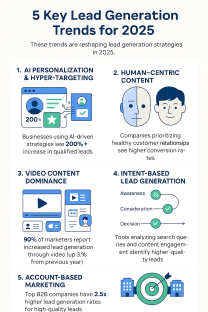
To create effective lead generation content in 2025, you need to understand and incorporate the latest trends shaping the industry.
AI Personalization and Hyper-Targeting
Artificial Intelligence has revolutionized how businesses approach lead generation. In 2025, AI-driven strategies ensure messaging resonates with customers by delivering tailored content, offers, and experiences to individual prospects.
How to implement:
- Use AI tools to analyze user behavior and create dynamic content that changes based on visitor attributes
- Implement predictive analytics to identify which leads are most likely to convert
- Create personalized content journeys based on previous interactions
- Use AI-powered chatbots to engage visitors and qualify leads in real-time
Human-Centric Content Strategies
Despite technological advancements, the human element remains crucial in lead generation. Businesses that emphasize authentic, human-centered approaches are seeing better results than those relying solely on automation.
How to implement:
- Showcase real customer stories and testimonials
- Create content that addresses emotional needs alongside practical ones
- Use conversational language that connects on a personal level
- Incorporate user-generated content into your lead generation strategy
- Highlight the people behind your brand
Video Content Dominance
Video continues to be a powerful lead generation tool in 2025. According to recent statistics, video marketing has helped increase lead generation for 90% of marketers, up 3% from previous years.
How to implement:
- Create short, engaging videos explaining your products or services
- Develop how-to videos that solve common customer problems
- Host live webinars and workshops
- Create video testimonials featuring satisfied customers
- Use video content on landing pages to increase conversion rates
Intent-Based Lead Generation
Understanding and targeting user intent has become increasingly important. Intent-based lead generation tools analyze search queries, website visits, and content engagement to identify ready-to-convert leads.
How to implement:
- Create content that addresses specific search intents (informational, commercial, transactional)
- Develop decision-stage content for high-intent keywords
- Use behavioral triggers to deliver the right content at the right time
- Implement intent data to prioritize leads for sales follow-up
Account-Based Marketing (ABM)
ABM continues to gain traction as a targeted lead generation strategy. This approach focuses resources on a set of target accounts within a market, treating each account as its own market.
How to implement:
- Create personalized content for specific target accounts
- Develop industry-specific resources that address unique challenges
- Use predictive analytics to identify high-value accounts
- Coordinate marketing and sales efforts for a unified approach to key accounts
Creating High-Converting Lead Generation Content
Now that we understand the trends shaping lead generation in 2025, let’s explore how to create content that effectively converts visitors into leads.
Understanding Your Audience
The foundation of effective lead generation content is a deep understanding of your target audience. Without this knowledge, even the most sophisticated strategies will fall flat.
Steps to understand your audience:
- Develop detailed buyer personas: Go beyond basic demographics to understand motivations, challenges, goals, and behaviors of your ideal customers.
- Conduct customer interviews: Speak directly with existing customers to gain insights into their decision-making process.
- Analyze customer data: Use analytics tools to identify patterns in how your audience engages with your content.
- Monitor social listening: Track conversations about your brand, products, or industry to understand what matters to your audience.
- Map pain points to solutions: Identify specific challenges your audience faces and how your product or service addresses them.
Remember that in 2025, audience understanding goes beyond traditional segmentation to include intent signals and behavioral data that can inform more targeted content creation.
Mapping the Customer Journey
Different types of content serve different purposes throughout the customer journey. Mapping content to each stage ensures you’re providing the right information at the right time.
Awareness Stage: At this stage, potential customers are just becoming aware of a problem or opportunity. Content should focus on education and building trust.
- Blog posts addressing common pain points
- Thought leadership articles
- Educational videos
- Infographics explaining industry trends
- Podcasts featuring expert discussions
Consideration Stage: Prospects are now evaluating different solutions to their problem. Content should help them understand the available options and why your solution stands out.
- Comparison guides
- Case studies
- Product demonstration videos
- Expert webinars
- Interactive tools
- Free trials or samples
Decision Stage: Leads are ready to make a purchase decision. Content should provide the final push needed to convert.
- Detailed product specifications
- Customer testimonials and success stories
- Free consultations or assessments
- Implementation guides
- ROI calculators
- Limited-time offers or incentives
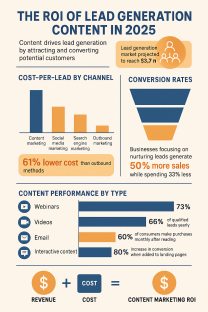
Content Types That Generate Leads
Different content formats can be effective for lead generation, depending on your industry and target audience. Here are some high-performing content types for 2025:
Ebooks and Whitepapers These comprehensive resources address complex topics in depth, positioning your brand as an authority while providing significant value to prospects.
Interactive Content Quizzes, assessments, calculators, and configurators engage users actively, resulting in higher conversion rates compared to passive content.
Webinars and Virtual Events Live or on-demand presentations allow for direct engagement with prospects while demonstrating expertise. According to recent data, 73% of B2B marketers say webinars are among the best ways to generate high-quality leads.
Case Studies Real-world examples of how your product or service solved specific problems for customers can be powerful conversion tools, especially for B2B lead generation.
Templates and Tools Practical resources that help prospects do their jobs better or solve immediate problems can be compelling lead magnets.
Original Research and Reports Unique data and insights not available elsewhere can attract high-quality leads interested in industry trends and benchmarks.
Optimizing Content for Search Engines
For lead generation content to be effective, it must be discoverable. SEO remains a critical component of lead generation in 2025, with some key considerations:
Keyword Research Focus on high-intent keywords that indicate purchase readiness. These might have lower search volume but often convert at higher rates.
Search Intent Optimization Create content that aligns with the intent behind searches rather than just matching keywords. Intent-based content performs better in search results and converts at higher rates.
Focus on E-E-A-T Google’s emphasis on Experience, Expertise, Authoritativeness, and Trustworthiness means your content should demonstrate genuine knowledge and firsthand experience.
Technical SEO Ensure your lead generation pages load quickly, are mobile-friendly, and provide a seamless user experience to maximize conversions.
Related Keywords Include semantically related terms in your content to help search engines better understand the topic and context of your pages.
Building a Lead Generation Content Strategy
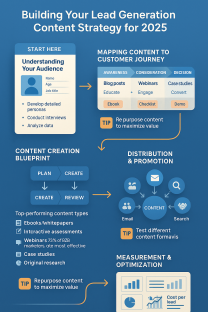
Individual pieces of content, no matter how well-crafted, won’t drive sustainable lead generation without a cohesive strategy. Here’s how to build an effective lead generation content strategy for 2025:
Setting Measurable Goals
Start by defining what success looks like for your lead generation efforts. Goals should be specific, measurable, achievable, relevant, and time-bound (SMART).
Examples of lead generation goals include:
- Increase conversion rate on landing pages from X% to Y% by the end of Q2
- Generate X number of qualified leads per month from content downloads
- Reduce cost per lead by X% through organic content strategies
- Increase lead-to-customer conversion rate by X% through better content qualification
Content Planning and Calendar
A strategic content calendar ensures consistent delivery of lead generation assets while maintaining quality and relevance.
Tips for effective content planning:
- Align content creation with key business initiatives and seasonal opportunities
- Balance different content types across the customer journey
- Plan for content repurposing to maximize the value of each asset
- Schedule regular content audits to identify gaps and opportunities
- Incorporate data-driven insights to refine your content calendar
Distribution Channels
Even the best lead generation content won’t perform if it doesn’t reach your target audience. A multi-channel distribution strategy maximizes visibility and engagement.
Key distribution channels for 2025:
- Organic search: Optimize content for discoverability through search engines
- Email marketing: Segment your audience for targeted content delivery
- Social media: Share content across platforms where your audience is active
- Communities and forums: Participate in relevant online communities
- Partnerships and guest content: Leverage other brands’ audiences
- Paid promotion: Amplify high-performing content through targeted ads
Lead Nurturing Workflows
Capturing leads is just the beginning. A strategic nurturing process moves leads through the funnel toward conversion.
Components of effective lead nurturing:
- Lead scoring: Prioritize leads based on engagement and fit
- Email sequences: Deliver progressive content based on lead behavior
- Remarketing: Re-engage leads across digital channels
- Personalized follow-ups: Tailor outreach based on specific interests
- Sales enablement content: Equip sales teams with relevant materials
- Cross-platform nurturing: Create cohesive experiences across channels
Measuring Lead Generation Content Success
To continuously improve your lead generation efforts, you need to measure performance and make data-driven decisions.
Key Metrics to Track
Quantity Metrics:
- Number of leads generated
- Conversion rates by content piece and channel
- Cost per lead
- Traffic sources
Quality Metrics:
- Lead qualification rate
- Sales accepted leads
- Lead-to-customer conversion rate
- Customer acquisition cost
- Customer lifetime value
Engagement Metrics:
- Time on page
- Content downloads
- Form completion rates
- Return visits
- Social shares
Attribution Models
Understanding which content pieces contribute to conversions helps optimize your strategy. In 2025, sophisticated attribution models provide more accurate insights:
Multi-touch attribution: Assigns value to each touchpoint in the customer journey, recognizing that multiple content interactions typically precede conversion
Time-decay models: Gives more credit to content consumed closer to the conversion point
Data-driven attribution: Uses machine learning to determine the actual contribution of each content piece based on patterns in your data
Continuous Optimization
Use performance data to refine your lead generation content strategy:
- A/B test landing pages, forms, and calls-to-action
- Optimize underperforming content based on analytics insights
- Double down on high-performing content types and topics
- Refine audience targeting based on conversion data
- Update existing content to maintain relevance and performance
Tools and Technologies for Lead Generation
The right technology stack can significantly enhance your lead generation efforts. Here are some essential tools for 2025:
CRM Systems
- HubSpot
- Salesforce
- Zoho CRM
- Pipedrive
Marketing Automation
- Marketo
- ActiveCampaign
- Mailchimp
- Klaviyo
Content Management
- WordPress
- Contentful
- Webflow
- HubSpot CMS
SEO and Content Analysis
- Semrush
- Ahrefs
- Google Search Console
- Clearscope
Lead Capture and Forms
- Unbounce
- Leadpages
- TypeForm
- Gravity Forms
Analytics and Reporting
- Google Analytics
- Hotjar
- Mixpanel
- Databox
AI and Personalization
- Drift
- Persado
- Optimizely
- Seventh Sense
Real-World Examples of Successful Lead Generation Campaigns
Case Study 1: B2B SaaS Company
A cloud-based project management software company implemented a comprehensive lead generation strategy featuring:
- Interactive assessment tool evaluating project management maturity
- Industry benchmark report requiring email submission
- Webinar series featuring project management experts
- Customer success story videos
Results:
- 45% increase in qualified leads
- 30% reduction in cost per acquisition
- 25% higher lead-to-customer conversion rate
Case Study 2: Financial Services Firm
A financial advisory firm created a lead generation campaign targeting small business owners:
- Free business valuation calculator
- Ebook on tax strategies for business growth
- Weekly newsletter with financial insights
- Virtual workshop series on business succession planning
Results:
- 65% increase in high-value leads
- 40% higher engagement with nurture emails
- 3x increase in consultation bookings
Case Study 3: E-commerce Retailer
A specialty online retailer implemented these lead generation tactics:
- Style quiz generating personalized product recommendations
- Lookbook requiring email for download
- Interactive product comparison tool
- Early access program for new collections
Results:
- 70% quiz completion rate
- 50% increase in email subscribers
- 35% higher average order value from leads
Conclusion
As we navigate the evolving landscape of digital marketing in 2025, effective lead generation content remains a cornerstone of business growth. The most successful strategies combine technological innovation with human-centered approaches, delivering value to prospects while building meaningful connections.
By understanding your audience deeply, creating targeted content for each stage of the customer journey, and continuously optimizing based on performance data, you can develop a lead generation system that consistently delivers qualified prospects to your business.
Remember that lead generation is not just about quantity—quality matters more than ever in today’s competitive environment. Focus on creating exceptional content experiences that address real customer needs, and the leads will follow.
Are you ready to transform your lead generation strategy for 2025? Start by evaluating your current approach against the trends and best practices outlined in this guide, then prioritize the areas with the greatest potential impact for your business.



